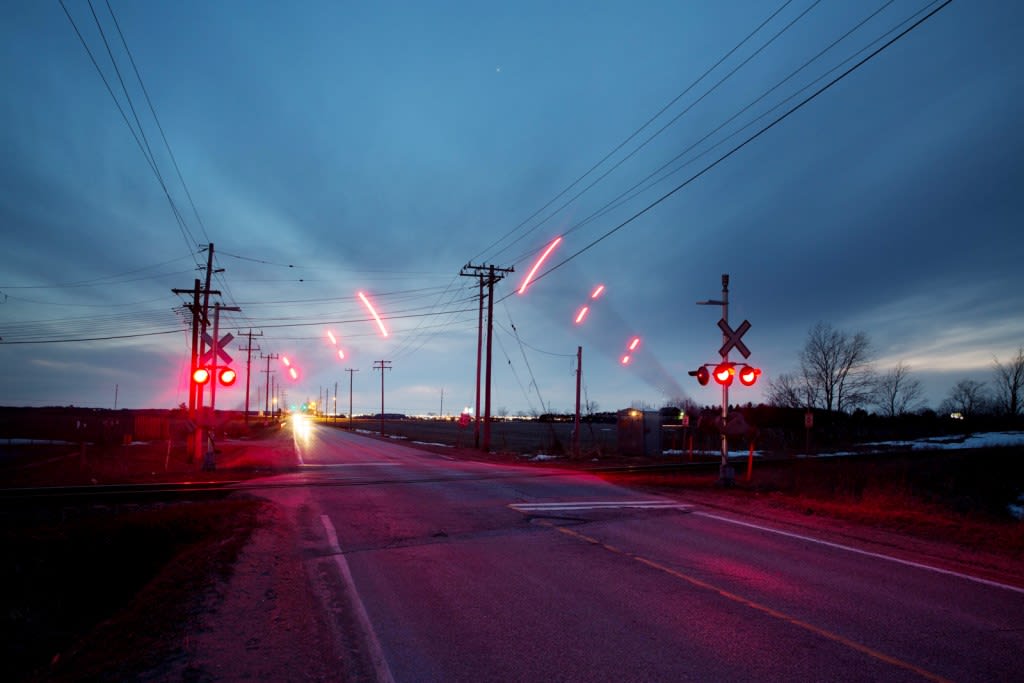Metrolinx looks to stop track tragedies around rail crossings
To reduce risks, new safety measures are being introduced to GO Transit and UP Express lines.
Sep 20, 2021
Crossing the tracks of a railway at a grade crossing may seem so routine, many people don’t even pay attention to the tracks under their tires or feet.
But the 139 public grade crossings that GO Transit and UP Express use daily – which are part of a vast network that reaches across the Greater Golden Horseshoe Region and beyond – are to be taken seriously.
Barriers come down at a crossing at night. (Metrolinx photo)
‘Grade crossings’, or ‘level crossings’, are points in the rail infrastructure designed for pedestrians and drivers to cross the tracks and are typically identified by a combination of vehicle barriers, signs, lights and bells. As Rail Safety Week begins (Sept 20-26) in Canada, the US and Mexico, experts are looking to ‘Stop Track Tragedies’, especially at grade crossings. To drive this message forward, Metrolinx is working with Operation Lifesaver, a non-profit group of rail safety educators now celebrating their 40th anniversary, to host public events in the coming days at stations across the network.
Throughout the course of Rail Safety Week, Metrolinx and Operation Lifesaver will be hosting educational events at several stations, which will include safety demo videos and safety equipment displays. Keep your eye out for our tents and personnel at the following times and locations!
- Port Credit GO Station – Today (Sept 20), 7:00AM – 9:00AM
- Union Station – Sept 21, 3:00PM – 6:00PM
- Aurora GO Station – Sept 22, 7:00AM – 9:00AM
- Union Station – Sept 24, 3PM – 5PM
Currently, Metrolinx moves trains over 139 public crossings, where publicly managed roadways intersect with rail traffic, as well as 30 private crossings, where railway tracks intersect with a road that is owned and used by private parties (such as farmers).
Additionally, more than one million cars and over 50,000 pedestrians and cyclists travel across these grade crossings every week. As Metrolinx continues to expand our rail network and increase services, there will be a train passing a grade crossing every eight minutes by 2030.
So, what makes grade crossing areas of particular concern for safety?
A GO train makes its way over a crossing – a routine but serious meeting or rail lines and a roadway. (Metrolinx photo)
First, grade crossings are unlike almost any other intersection because they involve trains that cannot stop quickly in the event of a person or object is on the tracks.
There is also a heightened risk that distracted drivers, cyclists or pedestrians ignore warning signs – a lapse that could put them in the direct path of an oncoming train and result in derailments, injuries, or fatalities.
The toll that grade crossing incidents can have on families is immeasurable. In the last three years, there have been 10 fatalities at grade crossings on the Metrolinx network. Each year, more than a hundred Canadians die or suffer serious injuries as a result of trespassing incidents on railway property or collisions at crossings.
The need to pay close attention to signs and safety measures is critical – this starts with effective safety measures across our network and increased education on grade crossing safety.
Every public grade crossing across the Metrolinx network has vehicular gates with flashing lights on either side of the approaches. These measures provide drivers an indication of when the crossing is active and are lowered in advance of the train’s approach. Once the train has safely cleared the crossing, the gate moves out of the way.
For crossings that have pedestrian and cyclist users, pedestrian gates with flashing lights and bells provide pedestrians and cyclists an indication of when the crossing is active. Stop lines are also clearly marked. Some crossings have been equipped with maze barriers – physical fencing intended to slow traffic as the public approaches before stopping at tactile plates. They are all cues that a crossing is approaching and to be aware.
A GO train moves quickly across a rural crossing. (Metrolinx photo)
In June 2021, Metrolinx introduced a new grade crossing enforcement pilot where an authorized vehicle is parked at grade crossings and equipped with a camera to monitor vehicles that are violating rules. In the last three months, officers have seen multiple vehicles idling on or near the tracks, at times requiring drivers to quickly get out of the way or turnaround. Vehicles should not be idling on tracks at anytime – it’s just not safe.
Looking to the future, plans are underway to implement further safety measures. This includes the installation of:
- Road embedded LED lights that would illuminate when the crossing is active to provide vehicular users extra awareness when a train is approaching
- Pedestrian gates with skirts will be installed to provide users with awareness of an active crossing and a barrier to restrict access to the rail corridor
- Pathway lights on all crossings that have a pedestrian path to guide pedestrians
- Anti-trespass mats on the right of way to deter pedestrians from shortcutting across the rail corridor
Want to know more about the safety mats? Here is that story.
Safety and awareness at grade crossings could mean the difference between life and death. Given the importance of grade crossing safety and our commitment to get everyone home safe, everyday, this article marks the first story in a series of articles, events, and resources that will be held and shared during Rail Safety Week.
Look for more features in the days ahead in Metrolinx News.
For more information on grade crossing safety, please check out Operation Lifesaver and the important work they do here, and you can check out the ‘Stop Track Tragedies’ campaign here.
Editor’s note – This story was updated and dates changed due to bad weather.
by Nolan Coelho Metrolinx Passenger and Public Safety Officer
